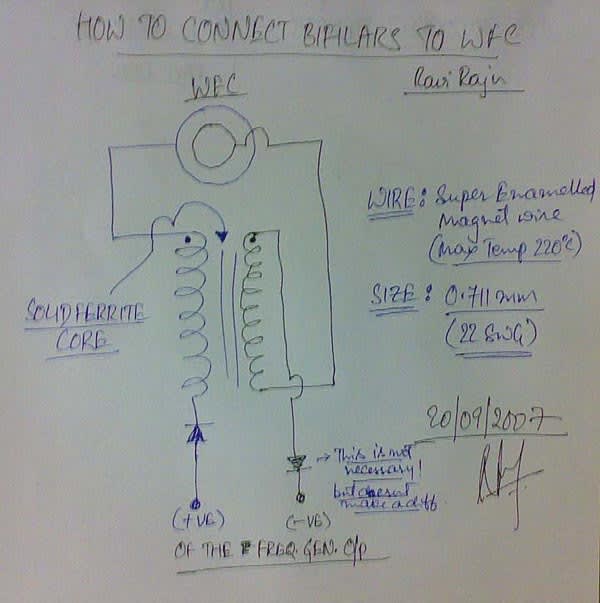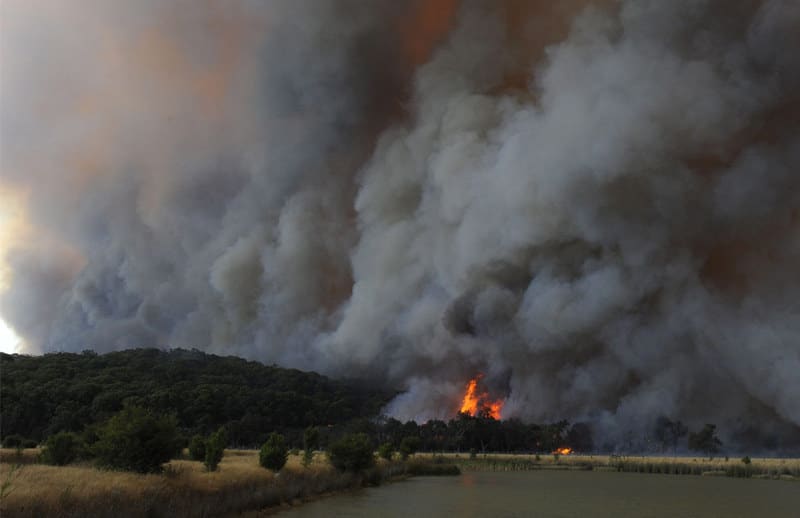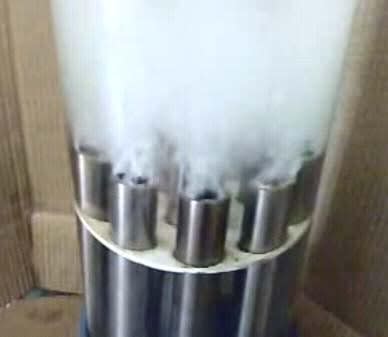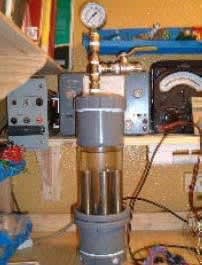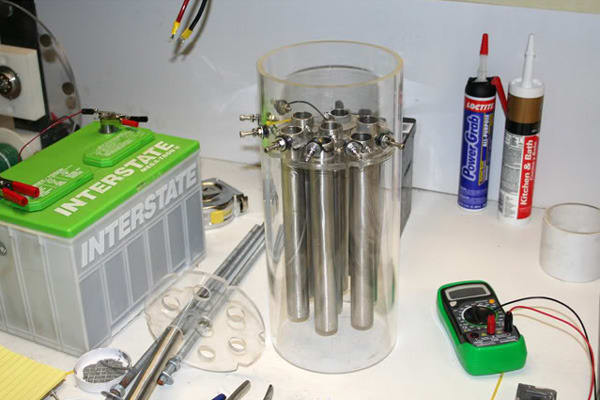Water Fuel Cell Voltrolysis Replication No.3
これからの転載は、GhostRiponさん(HN)の力作、傑作、
それではまだ言い足りない........。
勝れた業績である!!
詳しく読めば、誰でも水で走る車、水で起こす電気、水を利用して、
エネルギー革命が出来る!!
実際に作動してみる。その前段階で、慣らし運転というか、電極に絶縁体の生成を待つ必要があるようだ。これは所謂、電気分解でないという点に留意する必要がある。水は水道水でも、湖水でも何でも良いが、水質にも様々な違いがあるので、結果にも違いが生まれる。
水道水が望ましいようだ。出来るだけピュアな水が良いような雰囲気。と言うことからしても、伝導性を水に求めているのではなく、寧ろ、絶縁体の生成を待つと言うことであるから、水の電気分解とは概念が全く違う。
今回は、動画を駆使して実際を目の当たりに出来るので、臨場感がある。疑う人は何でも疑う傾向があるものだから、言うべき言葉もないが、素直に受け入れてみるのも一興というものであろう。
しかるべき慣らし運転を終えて、条件が整うと、水からガスが発生する。HHOガスである。無論のこと可燃性のガスであるから、注意を要する。換気環境を選ばなければならない。
この時、一定の周波数に於いて、ガスの発生は飛躍的に増大する。それに伴い、使用電力は暫減すると言うから不思議である。何事もやってみなければ分からない。
電気回路などには、不得手な方も多いであろう。投稿者もその例に漏れない。しかし、理解は出来る。不得手な部分はスルーしても、全体を汲み取ることは出来る。得意な方は、実際に挑戦してみられる恩寵がある。
【転載開始】
Water Fuel Cell Voltrolysis Replication No.3
テーマ:エコ&エネルギー
Panacea-BOCAF On-Line University
下記の文章は、『Ravi Cell(英語45ページPDF)』の解説をしているサイトhttp://h2o0il.com/の翻訳です。
見出しのページ番号は、『Ravi Cell(英語45ページPDF)』と対応してます。
詳しく読みたい方は、PDFをダウンロードして解読してください。
Research Paper on Ravi’s Water Fuel cell Replication
[Stanley Allen Meyer Page 18-20]
Video 2: This video shows freshly filled Tap Water. No other impurities (Read no Salts or Acids or anything at all just plain tap water and not distilled water) added.
ビデオ2: このビデオは新たに満たされた水道水を示します。不純物を加えたものではない。(蒸留水ではなく、また、塩や酸を追加していない普通の水道水です)
Additional options
In one of Stans patents he talked about using polyoxymethylene (Derlin)
which has a high dielectric constant. He used Derlin on the outside of
the outer pipe and the inside of the inner pipe to contain the electron
leakage. The barrier formed by the conditioning (explanation below)
coating has a comparatively lesser dielectric constant than the Derlin
material thickness used. Also D14 originally talked about creating
slots in the outer pipes. This has not been confirmed yet, and should
be investigated further.
スタン氏の特許のうちのオプションの1つ
は、高い誘電率(絶縁性)を持っているポリオキシメチレン(デルリン)を使うことについて述べています。彼は、リークを防ぐために、アウターパイプの外側
とインナーパイプの内側にデルリンを使用しました。調節(以下で説明)コーティングで形成されたバリアは、デルリンの材料厚より薄く、比較的少ない誘電率
を持っています。またD14は、外のパイプにスロットを作成することに関して話しました。これは、まだ確認されていないので、さらに調査されるべきです。
Conditioning
Average
time takes 4 weeks, based on Dave's and Ravi's reports. The impurities
in the water differ from place to place. This makes a huge difference.
You could see this difference by using ground water and water from
streams and lakes which has been exposed to sunlight. Ravi chooses to
use tap water.Electrode conditioning helps by providing an appropriate
insulating layer on the electrodes and that helps to lower useless
current leakage through the water. Check this video. You can see the
confirmation of non conductivity of the layer formed. The white
insulating coating formed during conditioning is non conductive in
between the tubes (pipe gap) so you need to take it for granted that
the process is basically dielectric breakdown of the bonds. The initial
conditioning is very important. Ravi recommends to only using the
following process described.
平均的な調節時間は、デイブ氏とラビ氏
のリポートによると4週間かかります。水の不純物は、地域によって違います。これは莫大な違いを生じさせます。あなたは日光にさらされている湖水と、川の
水、地下水とで違いを見つけることができると思います。ラビ氏は、水道水を使用することを選びました。調節された電極は、電極の上で適切な絶縁層を提供す
ることによって、無駄な(水を通しての)漏電電流を下げるのを助けます。このビデオをチェックしてください。[動画はリンク切れ]
調節層が形成され非伝導になったことを見ることができます。調節時に形成された白い層(絶縁コーティング)が、チューブ(パイプギャップ)の間で非伝導で
あるので、くっつく過程で、基本的に絶縁破壊されます。初期の調節は非常に重要です。 ラビ氏は、説明された以下のプロセスを唯一推薦します。
DO
NOT GO ABOUT CONDITIONING WITH HIGH AMPS ONLY AS YOU'LL ENDUP HAVING A
WEAKLY BONDED COAT ON YOUR NEGATIVE TUBES. LOW AMP CONDITIONING IN
EXTREMELY IMPORTANT FOR PROPER BONDING OF LAYERS TO THE BASE METAL and
the previous layers.The bond strength of the layer can be increased
further as after every cycle of conditioning. You need to stop for an
hour at least. During this period you can let the pipes air dry after
every er even more due to the loss of moisture from the surface. Then
change the water and go about the next conditioning cycle. Never touch
the layer till it dries up completely.
高いアンペア
だけで、調節に取り組まないでください。(-)極のチューブのコーティングの接着が弱く剥がれやすくなります。低いアンペアから調節をはじめることが重要
で、そうする事により、コーティングの適切な接着が得られ、層が厚くなります。層の付着強度はあらゆる調節サイクルの後に、さらに増加します。調節サイク
ル終了後、少なくとも1時間の間停止する必要があります。あなたがパイプを空気乾燥できるこの期間、表面から湿気を取り除いてください。次に、水を変えて
ください、そして、次の調節サイクルに取り組んでください。完全に乾燥するまで層には、決して触れないでください。
Ravi's procedure originally given to him by Dave Lawton:
1. Do not use any resistance on the negative side when conditioning the pipes.
2. Start at 0.5 Amps on freq gen and switch off after 25 minutes and stop for 30 minutes
3. Go to 1.0 Amps for 20 min and stop for 30 min
4. Go to 1.5 Amps for 15 min and stop for 20 min
5. Go to 2.0 Amps for 10 min and stop for 20 min
6. Go to 2.5 Amps for 5 min and stop for 15 min
7. Go to 3.0 Amps for 120 to 150 seconds.
You
will then need to check if WFC is getting hot, if it does you need to
reduce the time. AFTER THE 7 STEPS ABOVE LET THE WFC STAND FOR AT LEAST
AN HOUR BEFORE YOU START ALL OVER AGAIN. You would hardly see any gas
generation at the beginning and it makes a lot of brown muck. It took
Ravi and Dave about one month before the brown muck disappeared.
1.パイプのコンディショニングを整える時には、電源の(-)極に抵抗をつなげないでください。
2.0.5Aでパルス発生回路をスタートしてください、25分間作動させて、それから30分の間停止してください。
3.そして、1.0Aで20分間作動させて、それから、30分の間停止してください。
4.そして、1.5Aで15分間作動させて、それから、20分の間停止してください。
5.そして、2.0Aで10分間作動させて、20分の間停止してください。
6.5分の間2.5Aで作動させて、15分の間停止してください。
7.120から150秒の間3.0Aで作動させてください。
作動中に、セルチェックをして発熱しているようならば、作動時間を減らす必要があります。
上記7つのステップ終了後に、もう一度始める場合は、その前に最低1時間は、セルを休ませてください。
あなたは、このコンディショニング過程の初期段階では、ほとんどのガス発生も見ないでしょうが、多くの茶色の汚れ(の発生)を目撃するでしょう。茶色の汚れ(の発生)が消滅するのに、ラビ氏とデイブ氏は1ヶ月前かかりました。
Change
the water after every cycle initially. DONOT touch the tubes with bare
hands if the tube ends need to be cleaned of muck use a brush but do
not touch!! Ravi's experience showed that leaving the brown muck in
water for the next cycle goes on to heat up the water and you need to
avoid this. Over a period of time you will see a reduction in
generation of the brown stuff. When the muck is reduced you should see
a gradual decrease in the Amp draw for the same amount of generation.
An artist painting brush would be perfect to clean the tube ends during
and after conditioning. When you are conditioning you don't need to
connect the VIC -voltage intensifier circuit (Toroid + Inductors).
Eventually the pipes will not produce any brown stuff at all. At this
point you should now have a very good generation of gas. You will get a
whitish powdery coat on the surfaces. Never touch the pipes with bare
hands once this comes on.
最初は、あらゆるサイクルの終了のたび
に、水を交換してください。その際、素手で電極チューブに触れないでください。チューブの端を掃除する必要があるなら、ブラシを使ってください。ただし、
電極には触れないでください!!茶色の汚れが次のサイクルの間、水に残されているなら、水はそれで暖まります、そして、あなたはこれを避ける必要がありま
す。作業の終了は、最終的に茶色の汚れを全く見なくなるでしょう。汚れの減少度合いと比例して、セルでの使用アンペアが減少するでしょう。調節の時、およ
び調節の後に管端を掃除するために、塗装用ブラシを使用するのが良いです。慣らし中は、VIC- 電圧-電流変換器 (Toroid +
Inductors)を接続する必要はない。最終的にパイプは、どんな茶色の汚れも全く作り出さなくなるでしょう。この時には、非常によい(多く)ガスの
発生が見られるでしょう。チューブは、白っぽい粉末状のコートを表面に得ます。いったんコートが出来たら、素手でパイプに触れないでください。[Pulsed Water-splitters No.4(パルスを用いた水の分解) http://ameblo.jp/ghostripon/entry-10333372780.htmlと記述内容は同じ]
DO
THE CONDITIONING IN A WELL VENTILATED AREA OR PREFERRABLY CLOSE THE TOP
AND VENT THE GAS OUT IN THE OPEN. AS THE WFC IS LEFT ON FOR QUITE
SOMETIME EVEN SMALL AMOUNT OF GENERATION CAN GET ACCUMULATED IN A
CONSTRICTED SPACE AND COULD BE A HAZARD. The above process is to be
done after annealing the pipes. See to it that no oxide formation is
left on the pipe and use a detergent to wash off the pipes and rinse
them thoroughly with fresh water. Then assemble the setup including the
leads and base. Finally flush the pipes with lots of fresh water do not
touch the pipes with bare hands after this.
白
い絶縁コーティングが、(-)極に形成されます。必ず風通しの良い場所で調節するか、または、セル(容器)の蓋を閉じてください、そしてガスを戸外へ放出
してください。この過程の間、セルはかなりの時間動作しますので、ガス生産が非常に低い速度であっても、非常に危険な水素ガスが相当量蓄積されます。上記
のプロセスは、パイプを焼きなました後にすることです。
形成された酸化膜がパイプ上に残されていないように、洗剤を使用してパイプから洗い落し、淡水でそれらを徹底的にすすいでください。そして、リードとベー
スを組み立ててください。 最後は、綺麗になったバイプにたくさんの淡水を入れてください、この時に素手でパイプに触れてはいけません。
Aaron's video explaining about the non conductive Layer
When
the power is switched on you see bubble formation on the external
surfaces of the outer tubes just like in the video. This happens all
along during the conditioning process. Ravi states he remembers Dave
saying that you know the tubes are conditioned when these bubbles stop
forming on the external tube surfaces and you see a white powdery coat
on the tubes. Ravi went on conditioning even after that and ended up
with larger bubbles. 0Ravi states it is critical that people follow the
conditioning procedure as you get very uneven coat formation on the
surface if you use High Amps for long periods. When you go above 3 Amps
there's a possibility of the coating flaking off. The bonding between
layers would not be that strong. These layers form one over the other
after every cycle of conditioning. The small time high Amp conditioning
gives you an uneven coat and the long time low Amp conditioning evens
out this more or less. The longer you use Low Amp conditioning the
better the end outputs! Ravi has also used 0.2 amps for low amp
conditioning. This is ideal how ever time consuming. If you do the
procedure described above and still wish too build up a better coat
afterwards then you can use the 0.2 amp conditioning process
afterwards.
アーロン氏のビデオでは、非伝導の層について、パワーがONされたとき、まさしくビデオのようにアウタチューブの外側の表面で気泡が形成されることを説明しています。[動画はリンク切れ]
これは、調節プロセスの間にずっと起こります。
ラビ氏は、「これらの気泡が、外部のチューブ表面に形成されるのを終えて、チューブ上に新たな白い粉末状のコートが形成されることが終了の条件」と、デイ
ブ氏に言われたことを覚えていると述べます。ラビ氏は条件とし、その後の調整が進むと、より大きい気泡が発生すると続けます。もしも長い時間、高アンペア
での調整プロセスを行うならば、それは、表面に非常に不規則なコート形成を招く結果になるので、ラビ氏の調整プロセスに従うべきでしょう
。3アンペア超えで作業を行うとき、コーティングは、はげ落ちている可能性があります。チューブとコートの密着は、それほど強いくはありません。これらの
層は、各サイクルの調節後に、1層づつ積層され形成されます。小さい時間の高アンペアでの調節は不ぞろいなコートになり、そして、長い時間の低アンペアで
の調節は多少これをならします。あなたが、長い時間、低アンペアの調節をすればするほど、最終的なガスアウトプットは良くなります!ラビ氏は、低アンペア
調節のために、0.2アンペアを使用しました。このように時間がかかるが理想的です。
もし上で説明された手順をして、その後、より良いコートを確立したいというなら、後に0.2アンペアでの拡張コンディショニングを行ってください。
[Stanley Allen Meyer Page 21]
A
lot of people have been asking what the conditioning coat of Ravi looks
like plus why they shouldn't touch and why it can't be dismantled and
reassembled. Check: http://www.youtube.com/watch?v=leAtiaCygng
WFC Circuits Alternator Stevie's Unit For some there may be more losses
in the alternator than the solid state version. The original alternator
schematic will be included. It is recommended you use the solid state
version and get it working first. The alternator was only done by Dave
to mimic the car's operation in Stan's technology.
多
くの人々が、ラビ氏の調節コートが何に似てるか、そして、なぜ触れるべきでないのか、およびそれが、分解できず、組み立て直すことができないのかを尋ねて
います。WFCの回路(交流発電機仕様スティーブ氏のユニット)の交流発電機は、ソリッドステート仕様に比べてロスが多いです。(モーター駆動に2A)
そうなった要因は、オリジナルの回路図に交流発電機が含まれていました。実際に製作するならば、ソリッドステートを使用し、それを動作させることを推奨し
ます。 交流発電機仕様は、スタン氏が自動車用に考えた技術で、それをデイブ氏によって復元されただけです。[自動車なら、交流発電機を回す動力は、モーターではなくエンジン。それでも、ソリッドステート仕様の方が効率が良いと思います]
[Stanley Allen Meyer Page 22-23]
Bifilar Inductors Test
One
needs to experiment and search for superior circuitry as Stan Meyer
did. Stan had a better circuit which he never disclosed - the UK TV
documentary states that Stan would not even let them point a camera at
his more advanced cell. The inductors were actually part of the VIC.
Dave had used the exact specs (100 turns, wire dia, etc) of the
inductors mentioned in Stan's US Pat 4936961. Then Ravi had later added
the toroid and the diode as per the VIC which increased the efficiency
compared to using only the inductors. Ravi had not used the variable
inductor mentioned in the patent. His were wire wound like the ones
mentioned in the old D14, pg7.
スタン・マイヤー氏が実験と解析を
して作った、優れた電気回路が必要です。スタン氏は、決して明らかにしなかったより良い回路を持っていました-イギリスのテレビドキュメンタリーは、スタ
ン氏がそれらと高度なセルにカメラを向けさせてもらえなかったと述べます。インダクタは実際、VIC(電圧-電流変換器)の一部でした。デイブ氏は、スタ
ン氏のUS特許#4,936,961[http://www.nogw.com/download2/-9_meyer_water_electrolysis2.pdf]
において言及されたインダクタの正確な仕様(100回巻き、ワイヤの線径22SWGなど)を使用しました。そして、ラビ氏は、後にインダクタだけを使用す
るのと比べて、効率を増大させたVICに従ってトロイドとダイオードを追加しました。ラビ氏は特許で言及されている可変インダクタを使用していませんでし
た。彼のものは、古いD14、pg7において言及したように、巻き上げられたワイヤです。
[Stanley Allen Meyer Page 24]
Ravi
states "The inductor on both positive and negative is a must. I've made
it on a Ferrite rod of 25 mm length 100 turns of Double Enameled
Electrolytic Copper (99.99%) of 22 SWG (0.711mm dia)" which was what
Dave suggested." You will notice an increase in gas generation when the
bifilars are connected. Try with one in the beginning if it heats up
increase the number of inductors.
「(+)極と(-)極のイン
ダクタは、ともに必要なものです。私は22SWG(線径0.711mm)のエナメル線(銅99.99%)を、長さ25mm(250mm?)のフェラルロッ
ドに2本のエナメル線を平行に100回転巻きつけたもの(バイファイラー巻き)を作りました(デイブ氏が勧めたことでした)。」と、ラビ氏は述べます。
バイファイラーコイルが接続されているとき、あなたは、ガス発生の増加に気付くでしょう。初めに1度テストしてください、もし加熱するようなら、インダク
タの数を増やしてください。
[Stanley Allen Meyer Page 25]
Ravi
used 9 individual bifilar wound inductors for 9 tubes with 22SWG magnet
wires. The inductors and the toroid (Part of the VIC) do heat up after
a while and the efficiency comes down this happens due to the
temperature coefficient of resistance of copper. So the answer to this
problem would be to use bigger inductors and toroids and thicker wires.
ラ
ビ氏は9本のチューブに対し、9つのバイファイラーコイル(22SWG)を個々に接続しました。
しばらくして、インダクタとトロイド(VICの一部)が加熱して、効率が下がりました、これは銅の抵抗の温度係数のため起こります。
従って、この問題への答えは、より大きいインダクタ、トロイド、および、より太い線径ワイヤを使用することです。
[Stanley Allen Meyer Page 26]
The
VIC specs give as per patent 4936961 in Stanley Allen Meyer Page 6 of
the toroid size would probably be OK for a very small setup but may be
not for the lengths and the numbers Ravi is using. Stan gave a basic
idea of how it should be but we need to figure out the specs for our
own build sizes. My WFC is not a done thing its still in an
evolutionary stage and lot of combinations with the inductors are yet
to be tried out. The VIC basically needs a toroidal core and a 600V 40A
metal diode with a heat sink. The specs of wire sizes and turns are in
Stans US pat 4936961. He has a variable inductor in the patent on the
-ve side but what Ravi has is a regular inductor, two of them one on
positive and one on negative. Ravi states he would not suggest using
bifilars as inductors as they ended up shorting three of the tubes.
VICのスペックは、トロイドサイズのページ、スタンリー・アレンマイヤー氏の特許#4,936,961[http://www.nogw.com/download2/-9_meyer_water_electrolysis2.pdf]
(6ページ)に従って与えられます、使用には問題ないだろうけども、ラビ氏が使用しているセルのチューブ長と本数用のスペックではないでしょう
。スタン氏は、その部品が必要であるとの基本的な考え方を与えたけれども、私達は、個々のセルサイズのためのスペックを導き出せるようになる必要がありま
す。私のWFCで、インダクタとのたくさんの組み合わせを試されることになっています。基本的にVICには、ヒートシンクを持つドーナツ形をしたコアおよ
び600V40A金属ダイオードを必要とします。ワイヤサイズと巻き数の仕様は、スタン氏の特許#4,936,961に書かれてます。彼は特許において、
-ve側に可変インダクタを持っていますが、ラビ氏が持っているものは、不変のインダクタで、それらのうちの2つのうち、一つは(+)極、もう一つは
(-)極のです 。ラビ氏は、結局、3本のチューブをショートさせたので、彼はインダクタとしてバイファイラーコイルを使うことを勧めません。
The
100 ohm 0.25W resistors were replaced with 100 ohm 0.5W as 0.25W kept
burning out. The bifilar inductors are wound on ferrite cores using the
recommended turns stated in the original D14 document. When using
Ravi's version, you must use the diode to cut out the back EMF, Ravi
states that this is very important! And is what gives you huge
generation, this part is not mentioned by Dave or in D14. You end up
getting all the juice from the system only if your tubes are
conditioned enough. This video hows the higher output is all to do with
the inductors mentioned in the D14 circuit and conditioning and
slightly through the resistance wire to reduce the current draw. Even
without the resistance you can get the same output but another 0.3 to
0.6 amps extra but I feel this could be offset by making a bigger
inductor. Just go on conditioning and keep reducing the amp draw to the
WFC gradually and the generation would kind of remain the same even at
very low Amps. Once you condition the tubes your generation will
dramatically increase and the current required will fall by leaps. It
took Ravi almost 3 months approximately to reach these outputs.
100Ω0.25W
抵抗器は、焼損し続けたので、100Ω0.5W抵抗器に取り替えられました。バイファイラーインダクタは、オリジナルのD14文書において述べられた推奨
された巻き数でフェライトコアに巻かれます。ラビ氏のバージョンを使用するとき、あなたは、逆起電力(back Electromotive
Force:EMF)を切るのにダイオードを使用しなければなりません、ラビ氏は、これが非常に重要だと述べてます!そして、これは莫大な発生を与えるも
のであり、この部分については、デイブ氏またはD14においては言及されていません。もしチューブが十分に調節されているならば、システムから大量のガス
を得ることが最終的にできます。このビデオは、より高いアウトプットのすべての理由が、チューブの調節と、抵抗値を下げた導線とともに、D14回路におけ
るインダクタであることを示しています。抵抗なしで、同等のアウトプットを得られますが、追加で0.3Aから0.6A必要です、しかし、私は、より大きい
インダクタを作ることによってこれを相殺できるだろうと感じています。セルを調節し続けて、WFCにおいて消費されるアンペアを(徐々に)減らし続けてて
ください。そうすれば、発生は非常に低いアンペアで同じ量だけ行われるでしょう。セルを調節し続けていると、あるとき劇的に発生が増大するでしょう、そし
て、必要な電流も飛躍的に落ちるでしょう。これらのアウトプットに達するために、ラビ氏はおおよそ約3ヶ月かかりました。
NEXT>>Water Fuel Cell Voltrolysis Replication No.4
http://ameblo.jp/ghostripon/entry-10350464658.html
■過去記事
Water Fuel Cell Voltrolysis Replication No.1
http://ameblo.jp/ghostripon/entry-10346485209.html
Water Fuel Cell Voltrolysis Replication No.2
http://ameblo.jp/ghostripon/entry-10347229739.html
■関連記事
Pulsed Water-splitters No.1(パルスを用いた水の分解)
http://ameblo.jp/ghostripon/entry-10330994478.html
Stanley Meyer Data特許資料(英文) [pdf 221ページ]
http://www.free-energy-info.co.uk/MeyerData.pdf
Stanley Meyer - It Runs On Water(水で走る自動車)
http://ameblo.jp/ghostripon/entry-10328859717.html
【資料3】Stanley Meyer - It Runs On Water(水で走る自動車)
http://ameblo.jp/ghostripon/entry-10343331687.html
各セル構造の比較&検証(パルスを用いた水の分解)
http://ameblo.jp/ghostripon/entry-10335356396.html
【転載終了】



















